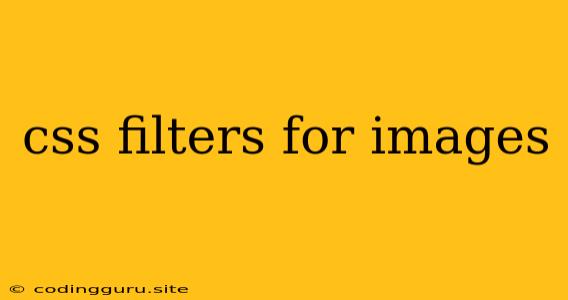CSS Filters for Images: Adding Creative Effects with Ease
Have you ever wanted to add a touch of artistic flair to your images without using complex image editing software? CSS Filters are the answer! This powerful tool allows you to manipulate images directly within your HTML and CSS, creating beautiful effects like blur, brightness, grayscale, and more. Let's dive into the world of CSS Filters and explore their vast potential.
What are CSS Filters?
CSS Filters are a powerful set of properties that allow you to apply various visual effects to elements on your webpage, especially images. They offer a non-destructive way to modify the appearance of an image without altering the original source file. This makes them ideal for experimenting with different styles and creating unique visual experiences.
The Power of filter Property
The key to using CSS Filters is the filter property. It takes a list of filter functions as its value, each one applying a specific effect. Let's explore some of the most common and useful filter functions:
1. Blur:
The blur() function adds a Gaussian blur effect to your image.
Example:
.my-image {
filter: blur(5px); /* Applies a 5-pixel blur */
}
2. Brightness:
The brightness() function controls the brightness of an image.
Example:
.my-image {
filter: brightness(150%); /* Makes the image 150% brighter */
}
3. Contrast:
The contrast() function adjusts the contrast of an image.
Example:
.my-image {
filter: contrast(150%); /* Increases contrast by 50% */
}
4. Grayscale:
The grayscale() function converts an image to grayscale.
Example:
.my-image {
filter: grayscale(100%); /* Completely grayscale */
}
5. Sepia:
The sepia() function applies a sepia tone to an image.
Example:
.my-image {
filter: sepia(100%); /* Full sepia tone */
}
6. Hue-Rotate:
The hue-rotate() function rotates the hue of an image.
Example:
.my-image {
filter: hue-rotate(90deg); /* Rotates hue by 90 degrees */
}
7. Invert:
The invert() function inverts the colors of an image.
Example:
.my-image {
filter: invert(100%); /* Completely inverts colors */
}
8. Saturate:
The saturate() function adjusts the saturation of an image.
Example:
.my-image {
filter: saturate(0%); /* Removes all saturation */
}
9. Drop-Shadow:
The drop-shadow() function adds a drop shadow effect to an image.
Example:
.my-image {
filter: drop-shadow(5px 5px 10px rgba(0, 0, 0, 0.5));
/* Creates a shadow with offset (5px, 5px), blur (10px), and color (semi-transparent black) */
}
Combining Filters
The beauty of CSS Filters lies in their ability to be combined. You can chain multiple filter functions together using spaces to create complex and unique effects.
Example:
.my-image {
filter: blur(3px) grayscale(50%) sepia(50%);
}
This code applies a 3-pixel blur, 50% grayscale, and 50% sepia tone to the image, creating a vintage-style effect.
Tips for Using CSS Filters
Here are some tips to help you get the most out of CSS Filters:
- Experiment! CSS Filters are easy to implement and change, so don't be afraid to play around with different values and combinations to find the styles you like.
- Use Browser Support Tools: Be mindful of browser compatibility. Use resources like to check if your desired filters are supported by the browsers you need to target.
- Consider Performance: Applying multiple complex filters can impact performance. Use filters sparingly and consider using optimized images to ensure a smooth user experience.
- Use CSS Variables: Use CSS variables to make your filter values easier to manage and adjust.
Conclusion
CSS Filters are a powerful and versatile tool that opens up a world of possibilities for enhancing and stylizing your web images. They offer a non-destructive approach, allowing you to experiment with different effects without altering the original source files. With their ease of use and flexibility, CSS Filters are a must-have in your web design arsenal.
